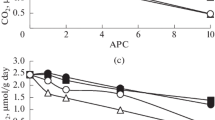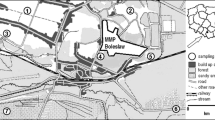Abstract
We have compared the impact of heavy metals (HMs: Cu 660 + Zn 1100 + Pb 650 mg/kg) on agrosoddy-podzolic soils (Albic Retisols (Loamic, Aric, Cutanic, Ochric)) of two arable fields (Chashnikovo, Moscow oblast) with different contents of organic carbon (Corg 3.86 and 1.30%) and different fertility levels using indicators of acute and chronic phytotoxicity. At the same level of polymetallic contamination, the responses of test plants to the presence of high concentrations of HMs and potential remediants (lignohumate and biochar) in soils of the same type with different Corg contents noticeably differ with respect to plant growth parameters and metal accumulation in the phytomass. The HMs contamination of low-fertile soil leads to the complete death of plants in the pot experiment, while plants on highly fertile soil continued to develop until flowering with only slight deviations from the control. Experimental data on the contents of total and water-soluble forms of HMs and nutrients in the studied soils are presented. The relationships between the chemical composition of soils and the results of phytotests have been found using the principal component analysis. It is shown that the threefold difference in the content of Corg between the soils of the same texture and acidity (pH) result in significantly different response of test plants to the same concentration of HMs. The necessity of correcting the standards for the permissible concentration of HMs in soils with due account for the Corg content in addition to pH and texture is discussed.



Similar content being viewed by others
Notes
ISO 18763:2016. Soil Quality. Determination of the Toxic Effects of Pollutants on Germination and Early Growth of Higher Plants.
Р 2.1.10.1920-04 Guidelines for Health Risk. Assessment of Exposure to Chemical Substances, Polluting the Environment (Approved by the Chief State Sanitary Doctor of the Russian Federation on March 5, 2004).
WRB (IUSS Working Group WRB. 2014. World reference base for soil resources 2014. International soil classification system for naming soils and creating legends for soil maps. World Soil Resources Reports No. 106. FAO. Rome.)
REFERENCES
Yu. N. Vodyanitskii, “Assessment of the total toxicological pollution of soils by heavy metals and metalloids,” Agrokhimiya, No. 2, 56–63 (2017).
Yu. N. Vodyanitskii, D. V. Ladonin, and A. T. Savichev, Soil Pollution by Heavy Metals (Moscow, 2012) [in Russian].
E. L. Vorobeichik, O. F. Sadykov, and M. G. Farafontov, Ecological Standardization of Technogenic Pollution of Terrestrial Ecosystems (Local Level) (Nauka, Yekaterinburg, 1994) [in Russian].
A. I. Ivanov, P. A. Sukhanov, Zh. A. Ivanova, and T. I. Yakovleva, “Agroecological significance of the degree of cultivation of sandy soddy-podzolic soils under Pb and Cd pollution,” Agrokhimiya, No. 4, 70–78 (2019). https://doi.org/10.1134/S0002188119040070
V. B. Il’in, “Heavy metals in the soil-crop system,” Eurasian Soil Sci. 40, 993–999 (2007).
V. I. Kiryushin, “Methodology for integrated assessment of agricultural land,” Eurasian Soil Sci. 53, 960–967 (2020). https://doi.org/10.1134/S1064229320070066
G. N. Koptsik, “Problems and prospects concerning the phytoremediation of heavy metal polluted soils: a review,” Eurasian Soil Sci. 47, 923–939 (2014).
A. P. Levich, “A biological concept of environmental control,” Dokl. Biol. Sci. 337, 360–362 (1994).
FR.1.31.2012.11560. Measurement of Biological Activity of Humic Substances by Fitoskan Phytotesting Method (Moscow, 2012) [in Russian].
T. M. Minkina, G. V. Motuzova, and O. G. Nazarenko, “Interaction of heavy metals with the organic matter of an ordinary chernozem,” Eurasian Soil Sci. 39, 720–726 (2006).
T. M. Minkina, G. V. Motuzova, O. G. Nazarenko, V. S. Kryshchenko, A. P. Samokhin, and S. S. Mandzhieva, “Accumulation of heavy metals in the barley plants on chernozem and chestnut soil,” Agrokhimiya, No. 10, 53–63 (2009).
O. V. Nikolaeva and V. A. Terekhova, “Improvement of laboratory phytotest for the ecological evaluation of soils,” Eurasian Soil Sci. 50, 1105–1114 (2017).
I. O. Plekhanova, O. A. Zolotareva, and I. D. Tarasenko, “Application of biotesting methods at assessment of ecological state of soils,” Moscow Univ. Soil Sci. Bull. 73, 164–174 (2018).
M. A. Pukalchik, V. A. Terekhova, M. M. Karpukhin, and V. M. Vavilova, “Comparison of eluate and direct soil bioassay methods of soil assessment in the case of contamination with heavy metals,” Eurasian Soil Sci. 52, 464–470 (2019). https://doi.org/10.1134/S1064229319040112
V. A. Terekhova, V. K. Shitikov, A. E. Ivanova, and K. A. Kydralieva, “Assessment of the ecological risk of technogenic soil pollution on the basis of the statistical distribution of the occurrence of micromycete species,” Russ. J. Ecol. 48, 417–424 (2017). https://doi.org/10.1134/S1067413617050125
S. A. M. Abd El-Azeem, M. Ahmad, A. R. A. Usman, K.-R. Kim, S.-E. Oh, S. S. Lee, and Y. S. Ok, “Changes of biochemical properties and heavy metal bioavailability in soil treated with natural liming materials,” Environ. Earth Sci. 70, 3411–3420 (2013). https://doi.org/10.1007/s12665-013-2410-3
N. Barsova, O. Yakimenko, I. Tolpeshta, and G. Motuzova, “Current state and dynamics of heavy metal soil pollution in Russian Federation—A review,” Environ. Pollut. 249, 200–207 (2019). https://doi.org/10.1016/j.envpol.2019.03.020
L. Beesley, E. Moreno-Jiménez, and J. L. Gomez-Eyles, “Effects of biochar and green waste compost amendments on mobility, bioavailability and toxicity of inorganic and organic contaminants in a multi-element polluted soil,” Environ. Pollut. 158, 2282–2287 (2010). https://doi.org/10.1016/j.envpol.2010.02.003
L. Beesley, E. Moreno-Jiménez, J. L. Gomez-Eyles, E. Harris, B. Robinson, and T. Sizmur, “A review of biochars’ potential role in the remediation, revegetation and restoration of contaminated soils,” Environ. Pollut. 159 (12), 3269–3282 (2011). https://doi.org/10.1016/j.envpol.2011.07.023
O. Bezuglova, “Molecular structure of humus acids in soils,” J. Plant Nutr. Soil Sci. 182, 676–682 (2019). https://doi.org/10.1002/jpln.201900043
C. Blok, G. Persoone, and G. Wever, “A practical and low cost microbiotest to assess the phytotoxic potential of growing media and soil,” Acta Hortic. 779, 367–374 (2008).
O. K. Borggaard, P. E. Holm, J. K. Jensen, M. Soleimani, and B. W. Strobel, “Cleaning heavy metal contaminated soil with soluble humic substances instead of synthetic polycarboxylic acids,” Acta Agric. Scand. 61, 577–581 (2011). https://doi.org/10.1080/09064710.2010.515602
M. B. Hinojosa, R. G. García-Ruíz, B. Viñegla, and J. A. Carreira, “Microbiological rates and enzyme activities as indicators of functionality in soils affected by the Aznalcóllar toxic spill,” Soil Biol. Biochem. 36 (10), 1637–1644 (2004). https://doi.org/10.1016/j.soilbio.2004.07.006
Remediation of Metals-Contaminated Soils and Groundwater: Technical Report No. TE-97-01 (Ground-Water Remediation Technologies Analysis Center, Pittsburgh, PA, 1997).
N. R. Meychik and I. P. Yermakov, “Ion exchange properties of plant root cell walls,” Plant Soil 234, 181–193 (2001).
N. Mirecki, R. Agič, L. Šunić, L. Milenković, and Z. S. Ilić, “Transfer factor as indicator of heavy metals content in plants,” Fresenius Environ. Bull. 24 (11), 4212–4219 (2015).
M. Pukalchik, K. Kydralieva, O. Yakimenko, E. Fedoseeva, and V. Terekhova, “Outlining the potential role of humic products in modifying biological properties of the soil—a review,” Front. Environ. Sci. 7, 80 (2019). https://doi.org/10.3389/fenvs.2019.00080
M. Pukalchik, F. Mercl, V. Terekhova, and P. Tlustoš, “Biochar, wood ash, and humic substances mitigating trace elements stress in contaminated sandy loam soil: evidence from an integrative approach,” Chemosphere 203, 228–238 (2018). https://doi.org/10.1016/j.chemosphere.2018.03.181
R. Singh, N. Gautam, A. Mishra, and R. Gupta, “Heavy metals and living systems: an overview,” Indian J. Pharmacol. 43, 246–253 (2011). https://doi.org/10.4103/0253-7613.81505
T. Stowhas, J. Verdejo, C. Yáñez, J. L. Celis-Diez, C. Enid Martínez, and A. Neaman, “Zinc alleviates copper toxicity to symbiotic nitrogen fixation in agricultural soil affected by copper mining in central Chile,” Chemosphere 209, 960–963 (2018). https://doi.org/10.1016/j.chemosphere.2018.06.166
J. Száková, M. Krýchová, and P. Tlustoš, “The risk element contamination level in soil and vegetation at the former deposit of galvanic sludges,” J. Soils Sediments 16, 924–938 (2016).
V. A. Terekhova, “Soil bioassay: problems and approaches,” Eurasian Soil Sci. 44, 173–179 (2011). https://doi.org/10.1134/S1064229311020141
M. Umlaufová, J. Száková, J. Najmanová, J. Sysalová, and P. Tlustoš, “The soil-plant transfer of risk elements within the area of an abandoned gold mine in Libčice, Czech Republic,” J. Environ. Sci. Health, Part A: Toxic/Hazard. Subst. Environ. Eng. 53, 1267–1276 (2018). https://doi.org/10.1080/10934529.2018.1528041
Y. Wang and L. O. Björn, “Heavy metal pollution in Guangdong Province, China and the strategies to manage the situation,” Front. Environ. Sci. 2 (9), 1–12 (2014). https://doi.org/10.3389/fenvs.2014.00009
R. A. Wuana and F. E. Okieimen, “Heavy metals in contaminated soils: a review of sources, chemistry, risks and best available strategies for remediation,” Int. Scholarly Res. Not. 2011, 402647 (2011).
S. K. Yadav, “Heavy metals toxicity in plants: an overview on the role of glutathione and phytochelatins in heavy metal stress tolerance of plants,” S. Afr. J. Bot. 76, 16–179 (2010).
O. S. Yakimenko and V. A. Terekhova, “Humic preparations and the assessment of their biological activity for certification purposes,” Eurasian Soil Sci. 44, 1222–1230 (2011). https://doi.org/10.1134/S1064229319070159
Q. Yang, Z. Li, X. Lu, Q. Duan, L. Huang, and J. Bi, “A review of soil heavy metal pollution from industrial and agricultural regions in China: pollution and risk assessment,” Sci. Total Environ. 42, (2018). https://doi.org/690-70010.1016/j.scitotenv.2018.06.068
ACKNOWLEDGMENTS
This research was performed according to the Development program of the Interdisciplinary Scientific and Educational School of M.V. Lomonosov Moscow State University “The Future of the Planet and Global Environmental Change.” We are grateful to Galina Vasilieva for the discussion, to Oleg Makarov for consultations, and to Pavel Uchanov for his help in soil sampling.
Funding
This study was supported by the Russian Foundation for Basic Research, project no. 18-04-01218а.
Author information
Authors and Affiliations
Corresponding author
Ethics declarations
The authors declare that they have no conflicts of interest.
Additional information
Translated by I. Bel’chenko
Rights and permissions
About this article
Cite this article
Terekhova, V.A., Prudnikova, E.V., Kiryushina, A.P. et al. Phytotoxicity of Heavy Metals in Contaminated Podzolic Soils of Different Fertility Levels. Eurasian Soil Sc. 54, 964–974 (2021). https://doi.org/10.1134/S1064229321060132
Received:
Revised:
Accepted:
Published:
Issue Date:
DOI: https://doi.org/10.1134/S1064229321060132




